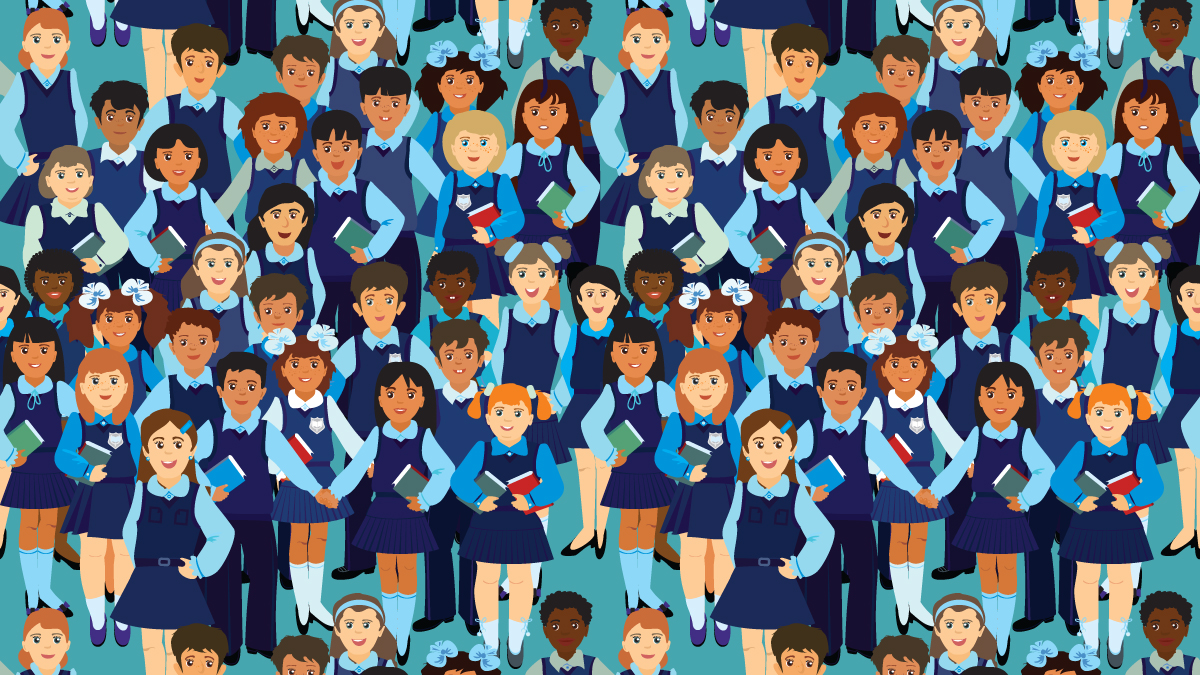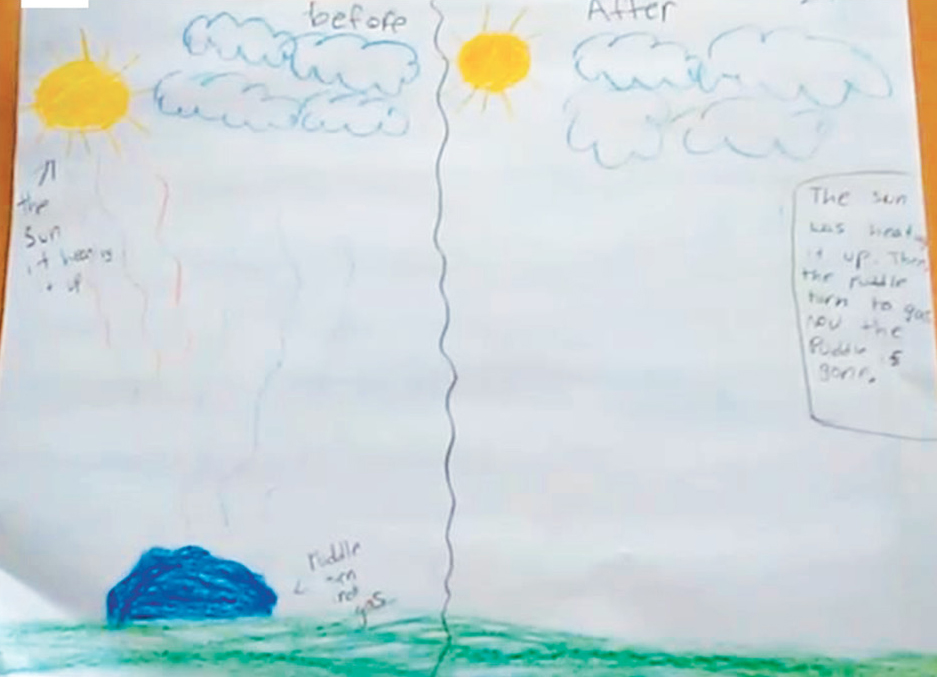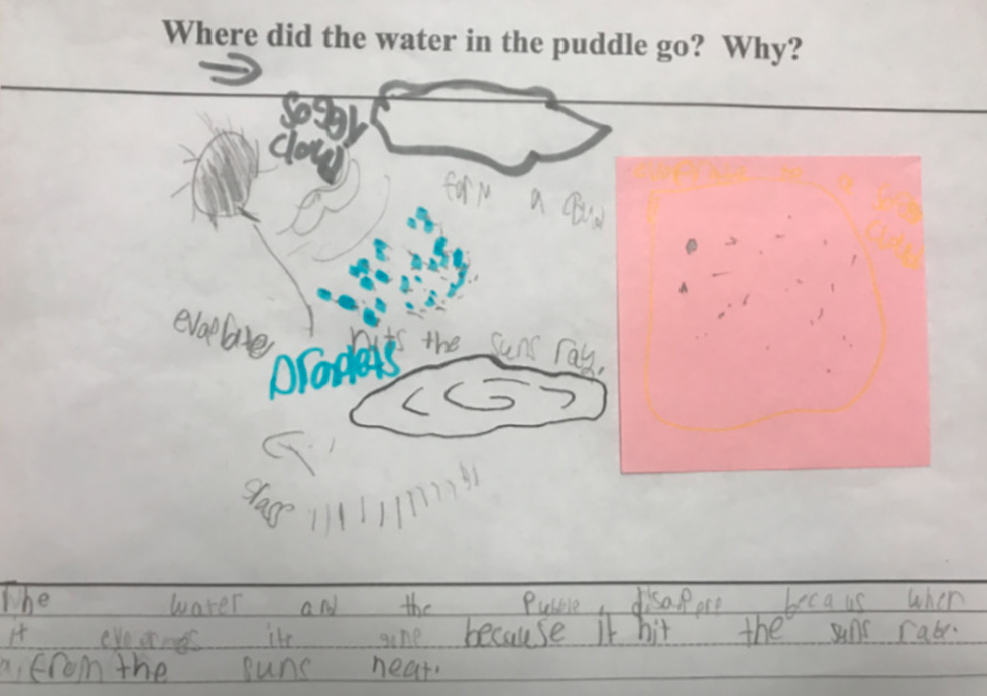feature
Mapping Vocabulary Onto Student Sense-Making
Strategies that encourage emergent bilingual students to make sense of science
Science and Children—November/December 2021 (Volume 59, Issue 2)
By Christa Haverly, Batoul Hossein, and Jennifer Richards

The population of emergent bilingual students (EBs, or English Language Learners, ELLs; see González-Howard, Suárez, and Grapin 2021) is growing steadily in the United States (National Center for Educational Statistics 2018). One common approach to language instruction for EBs is to expose students to a lesson’s content vocabulary before teaching the lesson to build students’ word banks and background knowledge. An example of this is the Sheltered Instruction Observation Protocol (SIOP; see Online Resources).
In this article we explore vocabulary instruction in the context of the Next Generation Science Standards (NGSS), which center students doing science and figuring out explanations for scientific phenomena (i.e., engaging in scientific sensemaking) rather than simply learning about science (Krajcik 2015; NRC 2012). This instructional shift challenges all teachers, but it may especially challenge teachers of EBs who are trained in strategies like SIOP. With an emphasis on figuring out, how and when can vocabulary best support students’ science learning? Should we teach EBs vocabulary before teaching the science lesson, as suggested by SIOP and other language acquisition models? Or should we encourage students to work with their own terms and ways of expressing ideas—and for how long?
Our position is that vocabulary should be taught during and after meaningful experiences with the science phenomena, not at the beginning of a lesson. Teaching EBs vocabulary prior to the science lesson or during an Engage section of a 5E science lesson problematically assumes that EBs are not capable of sensemaking about science unless vocabulary is front-loaded. Additionally, front-loading vocabulary gives away disciplinary ideas, which students are supposed to figure out. Instead, vocabulary can be introduced during later portions of science lessons or units (such as Explore/Explain sections in the 5E model) in the context of students communicating their ideas about science phenomena. This approach benefits monolingual students as well as bilingual and emergent bilingual students, though this article focuses on EB students.
Sense-making and Engagement through Scientific Modeling
Sense-making is a process by which students try to figure something out about a science phenomenon using their everyday knowledge and school knowledge (Odden and Russ 2018). Engaging students in sense-making means working on and with students’ science ideas (Campbell, Schwarz, and Windschitl 2016). Students do the intellectual work of engaging in scientific practices as they share science experiences in school, look for patterns, and collectively develop explanations about science phenomena (Gunckel 2010).
Rather than starting with vocabulary, the practice of scientific modeling can serve as a productive entry point for EBs to engage in and communicate their sense-making. Through developing and refining models, students construct their own explanations for a scientific phenomenon over time (NRC 2012; Windschitl and Thompson 2013), drawing on their ideas and experiences and increasingly on evidence from classroom experiences to account for how and why a phenomenon occurs. This process fosters both individual sense-making as students express their ideas through models, as well as collective sense-making as students use one another’s models to inform their own thinking.
Modeling is an accessible entry point for EBs because of its openness to multiple ways that students can express their current understandings. For instance, students may draw their ideas on paper or physically act out their ideas about a science phenomenon. Further, classes can generate shared ways of showing key ideas or processes, supporting communication and collaboration among students. Engaging EBs in modeling and shared experiences with phenomena makes learning the vocabulary in context easier for students than if they pre-learn the vocabulary without context.
K–2 Professional Development on Scientific Modeling
As a group, we led a professional development (PD) with several K–2 colleagues to introduce them to strategies for teaching with scientific modeling. Students at the school are predominantly from the Middle East and speak Arabic at home. Half the group’s teachers were bilingual in Arabic and English, and all were trained in SIOP and had ESL endorsements.
In this PD, all teachers taught the same mini-unit about the disappearance of a puddle of water (see a slightly updated version in the Online Resources). The focus of the PD was on pedagogy that could be applied across standards. Therefore, the unit served as an opportunity for teachers and students to engage in scientific modeling. The disappearing puddle phenomenon was particularly useful because it allowed for multiple hypotheses to be explored. For example, students may hypothesize about the role of evaporation in the puddle’s disappearance, the role of saturation into the soil, or the role of transpiration as the surrounding grass takes up water from the soil.
Through our PD, teachers learned how to sequence learning activities to provide students with opportunities to construct scientific models. Teachers learned to begin by introducing an accessible yet puzzling phenomenon (like the disappearing puddle), eliciting students’ initial ideas about how and why the phenomenon might be happening, and inviting students to construct initial models to explain the phenomenon. Following this, teachers used a planning tool to consider the varied hypotheses students presented in their models across the class, and then they led a lesson where students observed one another’s models and constructed a class-level model with common hypotheses and outstanding questions. Next, teachers provided students with experiences that would allow them to explore one or more of their hypotheses or questions. Finally, teachers were taught to have students revise their models to represent any shifts in their understanding based on their experiences.
Teachers also learned strategies for constructing scientific models. One strategy was to scaffold students’ models, for example by providing students with images of a changing puddle printed on sheets of paper to layer onto. Teachers were also taught modeling techniques such as using a zoom-in bubble to represent something happening on a scale that you can’t see, as well as techniques for revising models like using sticky notes to lay new ideas on top of old ones.
With the PD’s focus on strategies for scientific modeling, there was not a planned focus on vocabulary instruction. However, this quickly became a pressing concern as teachers were challenged to not introduce vocabulary about evaporation, saturation, and so on before the lesson. During the unit, teachers grappled with when and how to introduce vocabulary in a way that might serve students’ sense-making. This was unfamiliar and uncomfortable for many in our group.
Examples From Primary Grades
The K–2 classrooms at this school are 90–95% emergent bilingual. Students sit in small groups in their classrooms. The teachers generally group students heterogeneously based on their reading levels so that each group has a variety of abilities. Furthermore, students are encouraged to use Arabic in the classroom if they don’t speak English yet.
In the initial science talk where teachers elicited students’ noticings and wonderings about the puddle’s disappearance, teachers reflected that their students were initially uncertain about taking risks to express their ideas. As in many classrooms with EB students, teachers had students with varying levels of English proficiency, and many students had sufficient language skills to express their ideas even if they did not yet know vocabulary words like evaporate. Additionally, many students were able to reference background knowledge from previous science lessons or other learning experiences, use gestures, or leverage their peers and teachers to aid in communicating their ideas. The challenge was more about inviting the sharing of these ideas and experiences without fear of being wrong. For one teacher, students’ uncertainty with the science talk was alleviated once one student took a risk:
Once one of the students went out on a limb and provided an idea, “Rain falls on mud and the mud gets filled with rain,” students were more willing to share their ideas. It was amazing to see them reference previous lessons and use academic vocabulary they had learned beforehand, such as “evaporated.” They are really excited to find out what happens to the puddle!
In this example, a student began the science talk by sharing their experience related to the phenomenon using everyday language. This spurred other students to refer to science vocabulary they learned in previous units as they connected their personal experiences, their previous shared experiences, and the puddle phenomenon. Both everyday language and science vocabulary were accepted. To reiterate, this sense-making occurred without the teacher beginning with a vocabulary review.
Next, teachers asked students to create models of their ideas about the puddle phenomenon, and they video-recorded a few student explanations. In her reflection, one teacher noted:
When I videoed the students, I was interested to hear that more than one student had the same idea of the puddle “going into the ground.” I was also excited about how much time they put into their drawing and how much they wanted to talk about it. I feel in my classroom students are comfortable to take risks and share their thinking even if they are unsure of the answer. The students are also comfortable to say whether or not they agree or disagree with another student and they all try to explain (many times with scaffolding) their reasoning.
Creating a classroom culture where students are willing to take risks is important to engaging students in this kind of learning. (Look for resources for establishing this culture from Responsive Teaching in Science; see Online Resources.)
The examples in Figures 1 and 2 are screenshots from teachers’ videos of student models along with students’ verbal explanations. Students used a combination of everyday language along with academic vocabulary as they constructed initial explanations for this puddle phenomenon.
A second grader (Figure 1) used both the academic language of “evaporated” to explain the effect of the Sun on the puddle, as well as his everyday language of the Sun “opening” and “facing” the puddle. It is unclear what exactly the student understood about evaporation, but he thought that the water was “go”-ing somewhere, and it was directly caused by the Sun.

Second grader's initial modeling example.
“The Sun opened, and then it faced the puddle, and then the puddle putted—it got evaporated. And that’s how it made it go.”
A first grader (Figure 2) also used both academic language (roots) and everyday language (“sucking up the water”) to explain the phenomenon. As this student’s teacher, you might wonder where she came up with this idea. Asking probing questions to find out, such as “Why do you think that?” is a useful talk move to understand and promote further sense-making (see Talk Science Primer for more on talk moves; Michaels and O’Connor 2012).

First grader's initial modeling example.
“This is the water, and the roots are sucking up the water.”
Teachers planned subsequent activities and read-alouds based on—and to further—the ideas students were considering in their models. For example, if students thought water was being sucked up by the grass, teachers could plan for the classic celery experiment with colored water to explore this idea. (This was the most popular choice in our group!) Teachers then selected pages from an informational text to read aloud on related topics to supplement students’ explorations.
For many teachers, the read-aloud was an opportunity to begin introducing relevant academic vocabulary. This vocabulary was mapped onto ideas students had previously shared in their original model constructions and again in their celery explorations. Teachers drew from their ESL trainings and teaching experience to provide and reinforce academic vocabulary. The new strategy was presenting these vocabulary terms during and after students explored the phenomenon rather than beforehand. One teacher reflected:
By participating in this interactive read-aloud, ELL students may find it less challenging when later introduced to academic vocabulary. This particular process, in which students are able to make their own models and make connections as they learn, may make it easier for them to link new terms with ideas since they may have illustrated them and had tangible experiences with them in the experiment.
In other words, this teacher recognized that for EB (ELL) students, having vocabulary introduced after they already had engaged in sense-making through modeling and within the context of a phenomenon was easier for them. This was an important realization for teachers as their ELL training taught them the reverse.
In the final lesson, teachers had students revise their models to explain the puddle phenomenon. Figures 3 and 4 are examples from second graders.
A second grader (Figure 3) used the vocabulary word gas in her explanation, noted that the Sun was “heating” the puddle, and included wavy lines to show evaporation, though she did not name this process in her explanation. After just four lessons, she was able to use academic vocabulary to articulate several connected science processes.

Second grader's final modeling example.
“I think that the Sun was heating the puddle, and then the puddle turned to gas. Then the next day, the puddle was done.”
Figure 4 shares a revised model from the first student who originally described the process simply as evaporation. When questioned by his teacher, he noted that the water droplets (which he also called water vapor, drawn in blue) were going up to the “soggy cloud” (drawn in gray) at the top of his model because of “the Sun’s heat.” He combined academic language (Sun’s ray, water vapor) with everyday language (“soggy cloud” and the puddle “hits” the Sun’s rays) in order to more completely describe his understanding of evaporation.

A first grader’s revised modeling example.
“The water in the puddle disappeared because it evaporated and it’s gone because it hits the Sun’s ray.”
The sense-making happening with these two second graders was informed by their experiences in the classroom with activities, read-alouds, and discussions. Both students engaged in robust sense-making while introducing more academic vocabulary into their explanations.
Implications for the Classroom
We don’t mean to paint an overly rosy picture—by the end of this experience, many teachers in the group still questioned when the appropriate time was to introduce vocabulary in science. They were confused by contradictory messages from district administration to front-load vocabulary for EBs. It is difficult for teachers to navigate such conflicting messages, but based on the evidence we presented here, we invite careful consideration to introduce vocabulary later in a science unit sequence to give students multiple opportunities to engage in scientific sense-making, using their own language, first. To this end, we share a few ideas that may be helpful to support scientific sense-making with EBs:
A sample unit arc might go as follows: (1) Elicit ideas about a phenomenon (and construct models). (2) Engage in shared experiences based on ideas. (3) Use texts/videos to introduce concepts and vocabulary to consider. (4) Revise ideas (and scientific models) about the phenomenon using evidence.
Invite students to create models of science phenomena that are explanatory (i.e., show how and why) rather than descriptive—this promotes explanation and sense-making that extend beyond drawings.
Pay attention to students’ ideas (especially EB’s) and the language or representations they use to express them—map students’ expressions onto vocabulary as it is introduced, and thereafter.
Continually ask the question, “When do students need to know a term, and why?” It is reasonable to expect students to know vocabulary by the end of a unit; the question is when does it serve their sense-making? (Terms in science writ large are intended to support communication and clarification!)
Consider interchanging and maintaining students’ everyday terms (including in their home languages) and academic vocabulary during science.
For more on this topic, please read STEM Teaching Tool 66: Why you should stop pre-teaching science vocabulary and focus on students developing conceptual meaning first (see Online Resources). ●
Acknowledgments
We would like to acknowledge the support of NSF through grants RC103139 and DRL1417757 for funding to support this work. Further, we would like to thank colleagues at the University of Washington, particularly Jessica Thompson and Michelle Salgado, for their collaborative work on the design and implementation of the Scientific Modeling PD.
Online Resources
Puddles Mini-Unit Guide Grades K–2
https://ambitiousscienceteaching.org/puddles-mini-unit-for-k-1st-2nd-grade/
Responsive Teaching in Science
http://ase.tufts.edu/education/responsiveteachinginscience/toolbox_establish_norms.html
Sheltered Instruction Observation Protocol
http://www.cal.org/siop
Talk Science Primer
https://inquiryproject.terc.edu/shared/pd/TalkScience_Primer.pdf
STEM Teaching Tool 66
http://stemteachingtools.org/assets/landscapes/STEM-Teaching-Tool-66-Stop-Preteaching-Science-Vocabulary.pdf
Christa Haverly (christa.haverly@northwestern.edu) is a postdoctoral researcher in the school of education and social policy at Northwestern University in Evanston, Illinois. Batoul Hossein is a bilingual teacher at Riverside Middle School / Crestwood District in Dearborn Heights, Michigan. Jennifer Richards is a research assistant professor in the Learning Sciences at Northwestern University.
Interdisciplinary Literacy Three-Dimensional Learning Elementary


